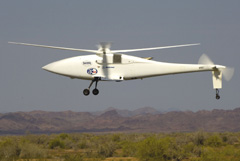
|
Boeing Flies A160T Hummingbird
Unmanned Rotorcraft for 18 Hours
|
|
|
5/21/2008 - ST. LOUIS -- The Boeing Company successfully flew its A160T Hummingbird unmanned rotorcraft for 18.7 hours May 14-15, claiming an unofficial world endurance record for unmanned aerial vehicles (UAVs) weighing between 1,102 and 5,511 pounds (500 to 2,500 kilograms). "We didn't set out to establish a world record, but it was a great accomplishment," said Jim Martin, Boeing Advanced Systems A160T program manager. "This 18-hour endurance flight is the culmination of thousands of hours of systems, ground and flight testing. The aircraft performed flawlessly, flying un-refueled longer than any other current unmanned rotorcraft. Our customers are excited about this important flight, the needs the A160T fills and the many options it gives warfighters." During the flight at the U.S. Army's Yuma Proving Ground in southwestern Arizona, the turbine-powered aircraft carried a 300-pound internal payload at altitudes up to 15,000 feet, landing with better than 90 minutes of fuel in reserve. The flight began May 14 at 8:55 p.m. (Pacific time) and ended May 15 at 3:36 p.m. Boeing has submitted an application to the National Aeronautic Association, the U.S. sanctioning body for the Fédération Aéronautique Internationale (FAI), to officially claim the world record. FAI establishes rules for the control and certification of world aeronautical and astronautical records. "With its ability to operate autonomously for extremely long durations while carrying heavy payloads, the A160T is perfectly designed for a variety of military missions," said Grady Eakin, Boeing Advanced Systems director of Business Development. "The A160T's large internal bays can accommodate multiple sensor payloads, allowing it to simultaneously perform persistent intelligence, reconnaissance, surveillance and target acquisition, communications relay, direct attack and other missions all in the same sortie. An externally mounted payload module can deliver heavy supplies or recover high-value assets with great precision." The aircraft used in the 18-hour test was one of the A160Ts Boeing Advanced Systems is building for customers including the U.S. Defense Advanced Research Projects Agency (DARPA), the U.S. Army Aviation Applied Technology Directorate and U.S. Naval Air Systems Command. The same aircraft achieved another flight milestone May 9 by successfully completing hover-out-of-ground-effect (HOGE) demonstrations at altitudes of 15,000 and 20,000 feet. "The HOGE was an important flight because it showcased a highly desirable capability that other unmanned rotorcraft can't deliver," said Martin. "Being able to hover at high altitudes puts the A160T above certain mountainous areas and out of range of some ground defenses, while maintaining persistent intelligence, reconnaissance, surveillance and target acquisition, and performing other missions for troops on the ground. The 15,000-foot HOGE met the DARPA goal. We exceeded that goal with the 20,000-foot test point." The HOGE demonstration flight lasted 2.9 hours, including hovering for more than seven minutes. The HOGE and 18-hour endurance flights completed all planned Phase I flight test demonstrations for DARPA. Since 2007, the A160T has reached a speed of 142 knots, recorded an eight-hour flight carrying more than 1,000 pounds of payload and recorded a 12-hour flight carrying more than 500 pounds, all using a fraction of its maximum fuel capacity. The Hummingbird features a unique optimum-speed-rotor technology that significantly improves overall performance efficiency by adjusting the rotor's speed at different altitudes, gross weights and cruise speeds. The autonomous unmanned aircraft, measuring 35 feet long with a 36-foot rotor diameter, eventually will fly more than 140 knots with a ceiling of 20,000 to 30,000 feet (high hover capability up to 15,000 feet) for more than 20 hours. Source: Boeing Press Release |
|
|
All original content Copyright © 2006 - 2008 The North Spin
